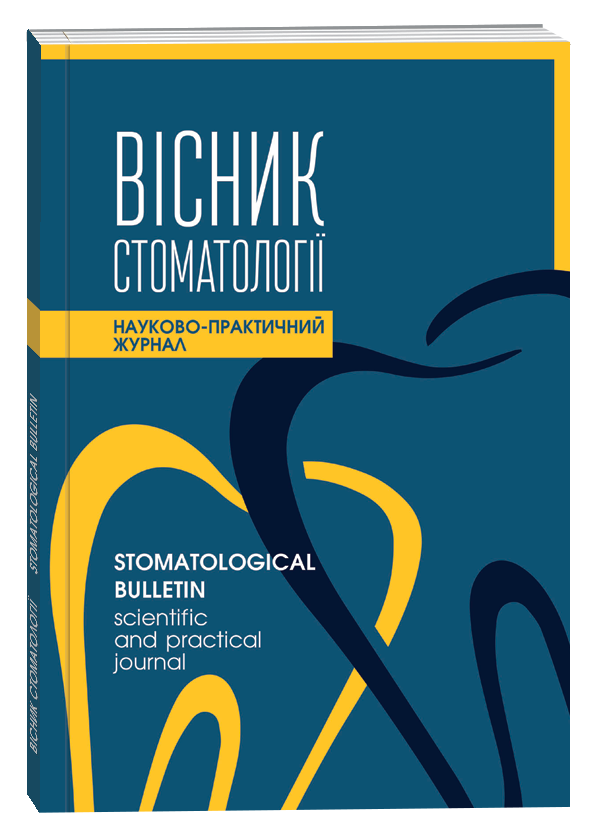TOPOGRAPHIC AND ANATOMICAL SUBSTANTIATION OF THE DIFFICULTY OF SWALLOWING DEPENDING ON THE SIZE OF THE POSTOPERATIVE DEFECT OF THE TISSUES OF THE ORAL CAVITY
DOI:
https://doi.org/10.35220/2078-8916-2021-41-3.4Keywords:
swallowing, gill arches, oral cavity, tongueAbstract
The article describes in detail the volume of defects, where the assessment of the postoperative defect is based on anatomical and physiological data of muscle groups and organs that correspond to the stages of formation of food lumps and swallowing. Thus, anatomical and physiological structures are systematized by us depending on the sequence of act of chewing and swallowing. The muscles involved in the act of biting, chewing and chewing include the anterior abdomen of the biceps, submandibular and masticatory, temporal, lateral and medial pterygoid muscles, which are innervated by the mandibular branch of the trigeminal nerve. The muscles that take part in lifting the root of the tongue up and shortening it, thus preparing the food lump to be pushed into the larynx beyond the pharyngeal-epiglottis fold – is the posterior abdomen of the biceps, sublingual, sublingual. Innervation is performed by the facial nerve, which provides a slow, adjustable muscle contraction. The third neuromuscular complex is the muscles of the larynx and pharynx. Here is a spontaneous stage of swallowing, uncontrolled passage of food into the larynx and esophagus. Innervation occurs mainly by the lingual-pharyngeal nerve. Purpose of the study. Topographic and anatomical analysis of the mechanism of swallowing and distribution of neuromuscular complexes of the mouth and pharynx, which participate in the formation of food lumps and swallowing, into three sections, which are ontogenetically related as derivatives of I, II and III gill arches. Assess the severity of swallowing disorders depending on the type and size of the postoperative defect. Scientific novelty. As a result of clinical observations based on anatomical distribution and ontogenetic origin, an analysis of swallowing disorders in the postoperative period from the size of the defect was performed. For the first time, patients were divided into groups from the volume of tissue removed and related disorders. The limits of surgery to preserve the swallowing function have been identified. Conclusions. 1. The distribution of the neuromuscular apparatus of the mouth and oropharynx by function is extremely important when planning surgical interventions and anticipating possible disorders of the formation of food lumps and swallowing. 2. The boundary of neuromuscular complexes between derivatives of the II and III gill arches is extremely important for the preservation of swallowing function. 3. Given the peculiarities of ontogenetic origin and innervation of neuromuscular complexes, the development of conduction blockades for tissue anesthesia in the postoperative period is of particular importance.
References
Bryan Bell R. Oral, head and neck oncology and reconstructive surgery. / R. Bryan Bell, R. Fermandes, P. Andersen. – Elsevier, 2018. 968 P. ISBN: 9780323265683
Галай О.О. Оптимізація хірургічних методів лікування хворих з місцево–розповсюдженим раком слизової порожнини рота і ротової частини глотки : автореф. дис. … докт. мед. наук : спец. 14.01.07 «Онкологія» Київ, 2012. 34 с.
Кравець О.В. Пластичне усунення дефектів дна порожнини рота шкірно-м’язовим клаптем підшкірного м’яза шиї / О.В. Кравець, В.С. Процик, О.В Хлинін. Клінічна онкологія. 2017. №3(27). С. 32–34.
Шувалов С.М. Избранные работы по челюстнолицевой хирургии. Винница, «ПрАО Виноблтипография», 2018. 264 с. ISBN 978-966-621-636-9
Head and Neck Oncology : Clinical Management / eds. A.R. Kagan, J.W. Miles. Oxford : Pergamon Press, 1989. 192 p.
Хендерсон Дж.М. Патофизиология органов пищеварения. 3-е изд., испр. Москва : Издательство БИНОМ, 2015. 272 с









